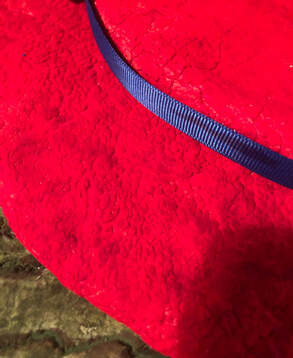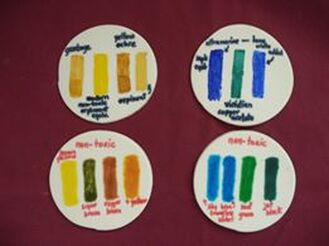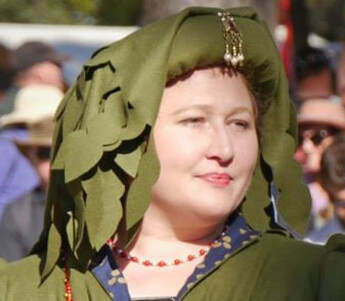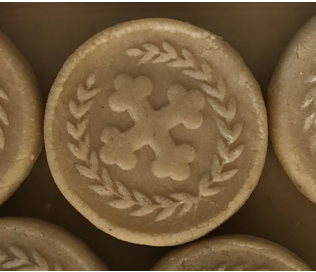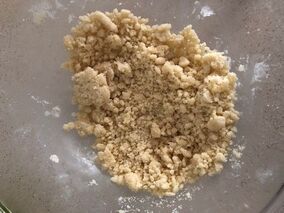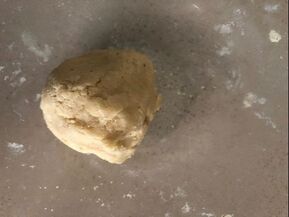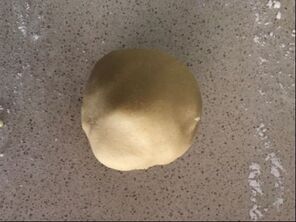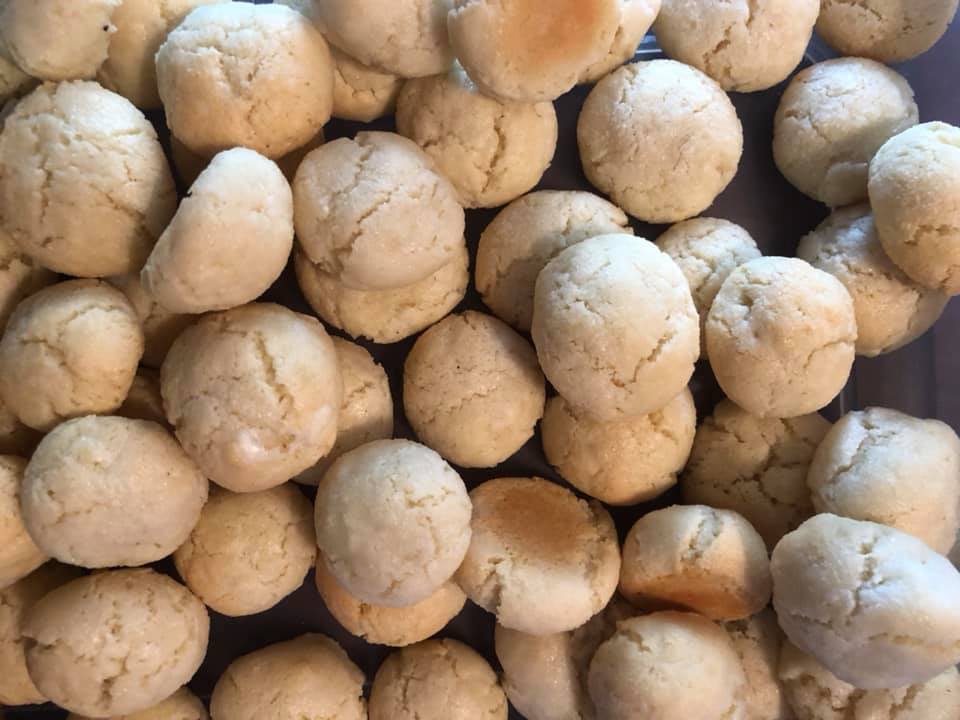Renaissance (16th Century England). Lactose Free. Gluten freeJelly and Aspic Experiments Part I "A gilded leche, leech or leach was served at Henry VIII's Garter Feast at Windsor in 1520, appearing in both the first and second courses. This rosewater-flavoured jelly featured as a chessboard with the 'black' squares gilded. Leach continued to be a favourite dish at other Garter Feasts until the seventeenth century. Leech was closely related to 'ribband jelly', a jelly moulded in multi-coloured layers, (ribbons), also popular in Tudor times." The Tudor Cookbook: From Gilded Peacock to Calves' Feet Pie By Terry Breverton
I was inspired by this Garter Feast, as told to me by Master Drake and Mistress Acacia, to create my own checkerboard. My practice run was more successful than the one I produced for the feast (a bit of a disaster as the jelly lost cohesion although it still tasted good!) as everything should be done in a cool room and remain well refrigerated to be successful. I didn't use a recipe as jelly flavours are fairly easy to create if you remember the following:
Ingredients Almond Milk Jelly
How to Milk an Almond, Stuff an Egg, And Armor a Turnip: A Thousand Years of Recipes by David Friedman and Elizabeth Cook 1988 How to make Almond Milk (p7) “Almond milk is an ingredient common in Medieval European recipes, particularly in Lenten dishes (milk, eggs, and meat broth all being forbidden in Lent). The recipe below is a basic one. For some recipes we make a thicker almond milk with more almonds relative to the amount of water; other recipes say “draw up a good milk of almonds with broth (or wine),” in which case the broth or wine is substituted for the water in making the almond milk. To make almond milk: Take ¼ c (1 ¾ oz) almonds. Put them in a food processor, run it briefly. Add a little water, run it longer. Continue adding water and running the processor until you have a milky liquid. Strain through several layers of cheesecloth. Put the residue back in the food processor, add a little more water, and repeat. Continue until the residue produces almost no more milk. Throw out the residue. This should give you about 1 c of almond milk.” Notes:
"Take a quart of almond milk and three ounces of gelatine, half a pond of beaten sugar; stir them together. Let it be thick. Then strain it with three spoonfuls of rosewater. Then put it into a platter and let it cool, and cut it in squares. Lay it fair in dishes, and lay gold upon it." Original source is Sir Hugh Plat’s Delights for Ladies, 1602 and The Tudor Kitchen: What the Tudors Ate & Drank By Terry Breverton "Leach of Almonds Ingredients: 1 cup almond milk, 1 ½ tbsp. of sugar, ¼ cup cream; tbsp. rosewater; ½ tbsp. gelatine." "Milk Jelly 1 pint fully fat milk or almond milk; 2-3 leaves of gelatine; 2 oz sugar" "Wine Jelly ¼ pint red wine or grape juice; 1 leaf of gelatine, 5-6 rose petals or a little rosewater."
0 Comments
or Digby Fine CakesRenaissance (16th Century England). Nutmeg, Mace and Gluten free These are a cross between a biscuit (cookie) and a cake. They are buttery, crumbly and delicious. Can be served at the end of a feast, as an afternoon pick me up or a wholesome snack on the run. The picture shown has a thin pelican patterned sugar plate disc and barberry on top. I have put all the measurements in teaspoons and grams as these are universal - sorry to anyone using imperial (Australian and US tablespoons are different measures) This recipe makes many, many cakes. It is great for the holiday season and you can play around with spices. Try adding ground ginger or the zest of a lemon for something different. Ingredients
Method
This recipe was adapted from "Excellent Small Cakes Revisited" by Tirloch of Tallaght. http://www.florilegium.org/files/FOOD-SWEETS/Digby-Cakes-art.text Stefan's Florilegium, 30 June 2001. Renaissance (16th Century England), Gluten Free, Dairy Free, Vegan.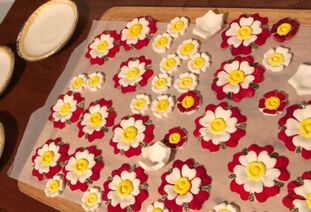 “Period subtleties served at feasts often included food items made to look like a completely different food item.” (ingen Dairmata, Accessed: 29 July 2019) The use of colour in food, particularly sweets, has long been a source delight. When sugar started to become more available in the sixteenth century, at least to the nobility, decorative sugar creations, often using plates as moulds became a feature of feasts. I became interested in learning about sugar paste as a way to contribute to the culinary life of my household as I cannot assist in the kitchen in mid-June. Taking the advice of his Excellency Master Drake Morgan, I made my first attempt at sugar plate using a pre-made modern paste. The feastocrat for the Canton of Stegby saw my first atempt at sugar plate and requested I attempt to create a subtlety to fit the Alice in Wonderland theme chosen for the 10 year aniversary. Stegby is a local chapter of the medieval and renaissance history group of the Australasian Kingdon of Lochac of the Society for Creative Anachronism (SCA). The original idea was to create bugs, slugs and snails as part of the Alice in Wonderland theme, but that didn’t work because:
Recipe I translated the Sir Hugh Plat recipe (Plat, 1602) , and then looked at other translations suggested to me by Baron Morgan. Ingredients Makes 350g (12oz)
(Smith, 2017) Drake’s recipe was similar and included rosewater Ingredients
(Morgan, 2019) I developed my own in order to get the quantity I needed:
I made three kilograms of paste to create the hat and base. I used a mould and tooling to create the base, a covered stiffened cardboard circle for the brim and a piece of cut styrofoam for the crown. I noticed that the paste cured quickly on the surface, meaning that all pieces had to be created quickly. This gave me the idea to make the velvet texture for the hat. I rolled out the paste and left it for half an hour so that when I moved it, the surface cracked - giving it the velvet looking texture I was seeking. I used modern moulds because I didn’t have time to create wooden moulds. The inside of the mould was coated with cornflower and the outside of each piece of gum paste was also dusted with cornflower before being finger pressed into the moulds. The pieces took between 2-8 days to fully cure. Colour The symbology of colour is important, particularly for an event hosting the crown. I focused on red for the hat (to contrast with the base), blue (for the ribbon and small items) and white (on the hat and small items). The symbology of the other colours were for the Alice in Wonderland theme – green and brown for the rabbit hole. Red, blue and white are kingdom colours. I used rose spirit and ground food colouring powder to create the colours. Some colours I used as is and others were as mixed to need. The ‘paint’ was made up to the consistency of poster paints or thickened cream. I applied the colours for the base and hat using a sea sponge. This gave the hat the velvet texture I was trying to achieve. I used a small brush for the fine work. The colours are admittedly not correct to the period. Unfortunately, I did not have the time to create the quantities of colouring using beet, pomegranate or carrots roasted in embers for red, mulberries for blue, blood raisins for black or amydon for white – brown and green can be achieved by mixing some of the above (ingen Dairmata, Accessed: 29 July 2019) (Fleming, 1996). I am hoping I can put together some colours for future creations and experiment with a fully authentic colour palette. All these colours are possible using period materials, as was demonstrated by EA Fleming in her 1990s samples she shared with me on 29 July 2019, below (she notes the silver has tarnished): Assembly
I used a small amount of sugar paste and sugar glue to attach all the pieces together. Serving Confectionery and Wafery: produced “the spiced and sweetened compounds or confections served as digestives at the close of dinners, suppers, and also at more intimate and luxurious entertainments.” P344 (Brears, 2008) This subtlety was served at the conclusion of the feast and was very well received. Once shown to the room it was taken back to the kitchen to be broken into pieces for serving. What I learnt
Renaissance (16th Century England). Gluten Free. Dairy Free. Vegan.About Marchpane is much less sweet than marzipan and tastes like fragrant almonds. The rosewater enhances the almond flavour and you can shape it into fanciful shapes or simple discs. A lovely addition to a desert board after a feast or a simple treat with tea. Ingredients
3. Shape into a ball. 4. Kneed for one minute into a smooth ball. 5. Press into moulds 6. Dry out in oven for 20 to 40 minutes at 90 degrees centigrade until uniformly white. 7. Decorate with royal icing and/or comfits if desired. This recipe is a redaction of a renaissance recipe. 'A book of cookrye. Very necessary for all such as delight therin', gathered by "AW" (AW 1591) How to make a good Marchpaine. First take a pound of long smal almonds and blanch them in cold water, and dry them as drye as you can, then grinde them small, and put no licour to them but as you must needs to keepe them from oyling, and that licour that you put in must be rosewater, in manner as you shall think good, but wet your Pestel therin, when ye have beaten them fine, take halfe a pound of Sugar and more, and see that it be beaten small in pouder, it must be fine sugar, then put it to your Almonds and beate them altogither, when they be beaten, take your wafers and cut them compasse round, and of the bignes you will have your Marchpaine, and then as soone as you can after the tempering of your stuffe, let it be put in your paste, and strike it abroad with a flat stick as even as you can, and pinch the very stuffe as it were an edge set upon, and then put a paper under it, and set it upon a faire boord, and lay lattin Basin over it the bottome upwarde, and then lay burning coles upon the bottom of the basin. To see how it baketh, if it happen to bren too fast in some place, folde papers as broad as the place is & lay it upon that place, and thus with attending ye shal bake it a little more then a quarter of an houre, and when it is wel baked, put on your gold and biskets, and stick in Comfits, and so you shall make a good Marchpaine. Or ever that you bake it you must cast on it fine Sugar and Rosewater that will make it look like Ice. http://www.foodsofengland.co.uk/marchpane.htm Another good source of information is: About Marzipan by Dame Alys Katherine http://damealys.medievalcookery.com/AboutMarzipan.html?fbclid=IwAR1Oo95EXfCZl1zbGQ6JShWMOpH4MWwLEoJZoDzMybRc7G2K2fhdYFYx9OA Recipe Notes
Renaissance (16th Century England), Gluten Free, Lactose Free.Ingredients
|
Dr. Nicola BoydI am trying to teach myself to be a medieval and renaissance confectioner. This has led to an interest in modern deserts too. |

